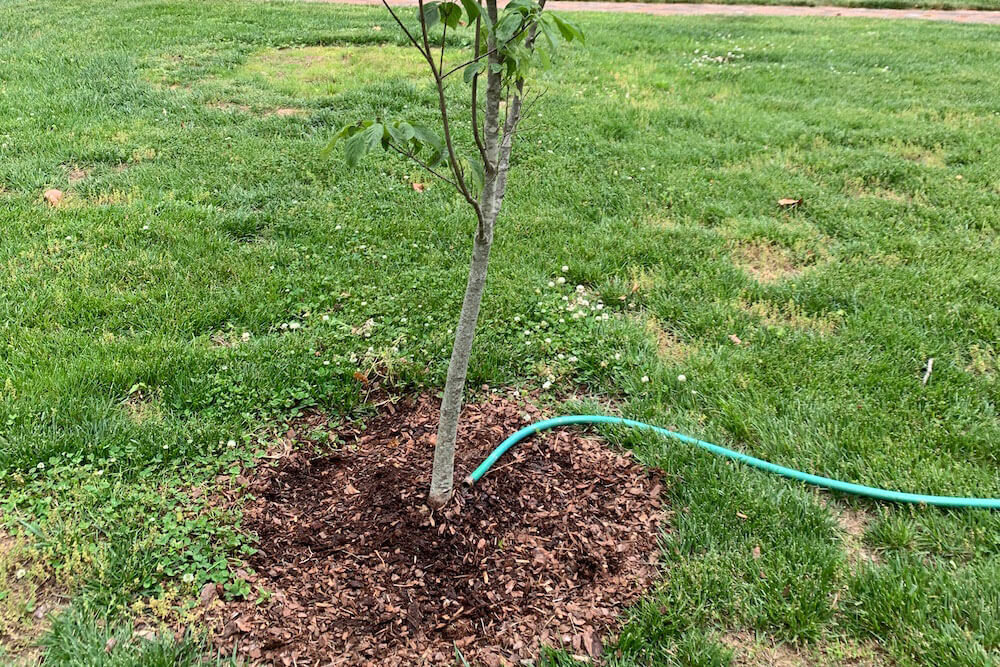How to Slowly Kill Your Tree, Part 4: Overwatering
Summer has officially arrived in Nashville, and that invariably means spells of hot, dry weather lie ahead. Providing water to your recently planted trees is a must. But too much water can harm the roots, so it’s important to understand exactly how much water your sapling needs.
A drip irrigation system with a timer can be especially convenient for watering young trees.
What to Know About Overwatering Trees
How Does a Tree Get Water?
In nature, trees grow underneath or next to their parent trees, and most of the seeds planted don’t make it to maturity. Those that mature remain in the same spot their whole lives, so their root systems are free to spread widely from the beginning. These wild trees usually get enough water from the rain and the water stored in the ground.
However, trees that are purchased and planted in a yard are typically grown in a container and have a ball-shape root system. Usually, our yards don’t have much groundwater stored, so we have to water a transplanted tree regularly over the first few years of its life to help establish it in place.
A long, slow trickle from a hose once a week or so is more effective than frequent drenchings.
Waterlogged Soil
A tree’s roots are used to eat, drink and breathe. Soil saturated with water can suffocate and drown a tree since the oxygen-rich air pockets are flooded. Root rot, fungus or too much water can kill a tree’s roots and slowly starve the rest of the tree.
Some signs that a tree is getting too much water include:
Wilting or yellowing leaves
Moss, fungus, and/or mushrooms at the base of the tree
Waterlogged blisters on stems and leaves
If you notice the soil is muddy or any of the signs listed above, stop watering and let the soil dry out. Planning before planting the tree will help avoid future problems.
Though it’s important to water your young trees during dry periods, too much water can be deadly.
How to Avoid Overwatering Soil
Don’t plant a tree in an area that holds water – Planting too close to a house might expose a tree to gutter runoff, which can quickly flood the roots. Don't choose a site where water collects or doesn’t drain well.
Don’t overwater with a hose or sprinkler – Find out how much water your tree species needs. Most likely, the ground around a tree will need to be watered once every week or two. If you didn’t purchase the tree, check with the Nashville Tree Conservation Corps or a certified arborist about what is appropriate.
Check the soil before you water – The dryness of the soil’s surface-level might be different than that of the soil 6 inches below. Use a trowel, a screwdriver, or another kind of soil probe to check the soil’s moisture before watering again.
Choose a tree species appropriate for your soil type – Some species, like Bald Cypress, Dogwood and Birch, thrive in wet soil, but most types of trees in your yard will be damaged by excess water.
Keep the soil aerated – When water fills the soil’s air pockets, this creates a serious problem for the tree’s roots. Make sure soil is porous and well aerated when it’s dry, since rain and manual watering can compact the soil after a while and remove the air pockets that are not only important for the roots to breathe, but for the bioactivity of the upper levels of the soil.
If you planted a new tree this spring, now is the time to learn about proper watering.
Recovering from Water Damage to Roots
When soil has been overwatered or flooded, you can’t do much to remove the water if the area can’t be drained. To know best how to manage the tree while it recovers, check with a certified arborist to evaluate the tree’s condition. They’ll be able to tell you the next steps to take over the period of time necessary for the tree to heal.
Damage from overwatering can happen to young and mature trees alike. Since the conditions of the soil are essential to the health of trees and plants, learning about the right balance of water for your yard’s soil will help you keep your tree hydrated, healthy and able to contribute to the neighborhood’s canopy cover.
For help with planting a new tree, contact us at the Nashville Tree Conservation Corps, and to stay updated with news and more tips on tree care, subscribe to our newsletter!




